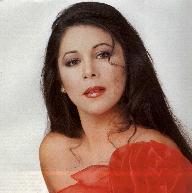 Maria Isabel Pantoja Martin was born on the 2nd August 1956 in Seville, at number 8 Juan de Diez Solis street, situated in San Gonzalo district, better known as "el Tardon", near Triana. Her paternal grandfather was "El Pipono de Jerez", gypsy singer. Her father, Juan Pantoja, who was nicknamed "Chiquetete", formed part of "Los Gaditanos" who made famous around the fifties the song "Que bonita que es mi nina", penned by F.del Val. Juan Pantoja wrote lyrics for some "fandangos". He was very much respected within the artistic world for his talent, and he never wanted her daughter Maribel to become an artist. Juan Pantoja was married to a flamenco dancer called Ana Martin. They both frequently worked with "Pepe Pinto and "La Nina de los Peines". In actual fact this two became the Godparents in their wedding. Later, Ana Maria formed part of "Juanita Reina's" group of dancers.
Maria Isabel Pantoja Martin was born on the 2nd August 1956 in Seville, at number 8 Juan de Diez Solis street, situated in San Gonzalo district, better known as "el Tardon", near Triana. Her paternal grandfather was "El Pipono de Jerez", gypsy singer. Her father, Juan Pantoja, who was nicknamed "Chiquetete", formed part of "Los Gaditanos" who made famous around the fifties the song "Que bonita que es mi nina", penned by F.del Val. Juan Pantoja wrote lyrics for some "fandangos". He was very much respected within the artistic world for his talent, and he never wanted her daughter Maribel to become an artist. Juan Pantoja was married to a flamenco dancer called Ana Martin. They both frequently worked with "Pepe Pinto and "La Nina de los Peines". In actual fact this two became the Godparents in their wedding. Later, Ana Maria formed part of "Juanita Reina's" group of dancers.
The marriage had four children: Bernardo, Maria Isabel, known as Maribel, Juan & Agustin. They went through great financial difficulties. So much was their financial crisis that Isabel's mother had to sell fruits and vegetables in a local market near her home in Seville. Isabel used to imitate her mother, when she saw her dance and sing.
 Isabel was only seven years old when she first stepped foot on a stage, it was in Seville in the theatre "San Fernando", the event was a tribute to "Juanito Valderama" and "Dolores Abril" who Juan Pantoja used to perform in their show. As a gift for her performance, Isabel was given three gas balloons.
Isabel was only seven years old when she first stepped foot on a stage, it was in Seville in the theatre "San Fernando", the event was a tribute to "Juanito Valderama" and "Dolores Abril" who Juan Pantoja used to perform in their show. As a gift for her performance, Isabel was given three gas balloons.
Her father went ill with hepatitis. It was the year 1969. Isabel went to Palma de Mallorca for a summer break, with her grandfather. This helped at home specially when having one less mouth to feed. In the Balearic Island Isabel's cousin "Antonio Cortes" known today as "Chiquetete" was performing with his wife Amparo. Isabel's grandfather helped in getting her a contract to form part in this family flamenco act. The proprietor of the "tablao" "El Rombo", paid Isabel five hundred pesetas daily. After just a week in the dancing act, Isabel became one of the singers. Her repertoire was limited to cover versions with a flamenco touch of well known hits at the time like "Gwendolyn", of Julio Iglesias and "Madrecita Maria del Carmen", of Manolo Escobar...
Shortly after "Chiquetete's" musical group was offered the recording of an album, Isabel took part in this recording. Naturally Isabel was not known then, but this recording which took part in a not very optimized studio became the first recording for the star, not even her realizing that later in her life she would record many more records. Her dream at this time was to become a "Flamenco" dancer, like her mother.
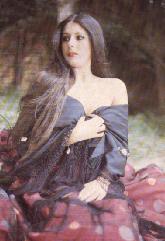 The girl was turning into a young woman, without hardly enjoying her childhood. She hardly played with girls of her own age. She used to go to school, attended dance and singing classes and she practically lived to her mother's orders, who was the head of the family, while her father was recovering from his illness.
The girl was turning into a young woman, without hardly enjoying her childhood. She hardly played with girls of her own age. She used to go to school, attended dance and singing classes and she practically lived to her mother's orders, who was the head of the family, while her father was recovering from his illness.
After ending their contract in Mallorca, the whole group returned to Seville. A businessman from Castilleja de la cuesta, a town very near Seville called Baldomero Negron, offered them a contract to perform in his "tablao" called "El Embrujo".
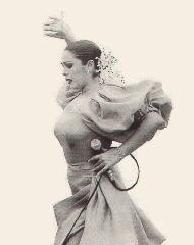 Isabel performed as a dancer, whilst her cousin Antonio Cortes (who later became the well known "Chiquetete") did the singing. She gets paid at the time two hundred pesetas daily. The owner of the "tablao" was amazed with Isabel performance and encouraged her to sing. Doing cover versions of hits from Juanita Reina,Marife de Triana and Rocio Jurado, being these her favorites artists at the time. Negron spoke with Rafael de Leon and Juan Solano during one of their stays in the Hotel Colon of Seville. The writer and the composer both accepted the invitation to go and see for themselves this new promising artist in the "El Embrujo".
Isabel performed as a dancer, whilst her cousin Antonio Cortes (who later became the well known "Chiquetete") did the singing. She gets paid at the time two hundred pesetas daily. The owner of the "tablao" was amazed with Isabel performance and encouraged her to sing. Doing cover versions of hits from Juanita Reina,Marife de Triana and Rocio Jurado, being these her favorites artists at the time. Negron spoke with Rafael de Leon and Juan Solano during one of their stays in the Hotel Colon of Seville. The writer and the composer both accepted the invitation to go and see for themselves this new promising artist in the "El Embrujo".
Negron really worked very hard to get Isabel known to this two famous writer and composer. He even took Isabel to the presentation of Conchita Marquez Piquer. There they met the one and only Dona (Lady) Concha Piquer, mother of Conchita and one of the big names of "La Copla" at that time. Eventually he managed to take Isabel to Juan de Leon's music Academy. It was situated in calle (street) de la Luna in Madrid, on the last floor with no lifts available, they arrived out of breath. The famous composer asked Isabel to sing whatever she knew and he will accompany her with the piano.
Life in Madrid was hard for Isabel. She lived with her mother in a very modest (pension) Inn. Her father feeling better of this illness returned from Seville and managed to get a contract in "El Corral de la Moreria" prestige "tablao" where many great flamenco artist passed by and had a selected clientele including great names from Hollywood at the time, who would pay the "tablao" a visit during their stay in the Spanish capital. Juan Pantoja ended up asking the generous proprietor of the "tabalo" Manolo del Rey, if he could help his daughter Maribel. Del Rey offered Isabel a place in his group of dancers, paying her five hundred pesetas daily. She was simply known in the group as Maribel. One day Isabel was asked to sing, and she did, her pay was increased to one thousand five hundred pesetas per day. Juan Solano, astonished by his young pupil, gave up other commitments he had, including composing for Rocio Jurado, to be able to dedicate totally to Isabel.
Shortly after Isabel's father died. Feeling really bad he left for Seville to die. Isabel accompanied his father in his last moments. Juan Pantoja was unable to live the success of his daughter, though he could foresee it.
 If we forget about the album she recorded with the flamenco act in Mallorca, her recording debut as a star was in 1974. Solano prepared the material for her first solo album. The opening track of side A was a track composed by himself and penned by Rafael de Leon, which had been previously recorded by Conchita Marquez Piquer with no luck,it was titled "Fue por tu voz". Followed by other tracks from the same authors like "Ten compasion de mi" and "Un rojo, rojo clavel", being this last one a massive hit for Rocio Jurado. The album also contained tracks from other authors like, Ochaita, Valerio and Solano.
If we forget about the album she recorded with the flamenco act in Mallorca, her recording debut as a star was in 1974. Solano prepared the material for her first solo album. The opening track of side A was a track composed by himself and penned by Rafael de Leon, which had been previously recorded by Conchita Marquez Piquer with no luck,it was titled "Fue por tu voz". Followed by other tracks from the same authors like "Ten compasion de mi" and "Un rojo, rojo clavel", being this last one a massive hit for Rocio Jurado. The album also contained tracks from other authors like, Ochaita, Valerio and Solano.
On the 26th May 1980, Isabel was in Jerez de la Frontera, attending the famous "fiestas" of this city. Isabel was staying at the Jerez Hotel, where one afternoon after the "Typical Spanish Bullfight" was over,she met a graphic reporter she knew called Manuel Gallardo, who invited her to go and congratulate the bullfighter Francisco Rivera known professionally as "Paquirri". The encounter was really short, with many people at the door of the bullfighter's hotel room. They hardly said a word, but they definitely fell for each other.
The wedding took place in Seville on the 30th April 1983. The press named the wedding as "the wedding of the year". Thousands of people surrounded the church waiting for the arrival of the bride and groom who came in Horse carriages.
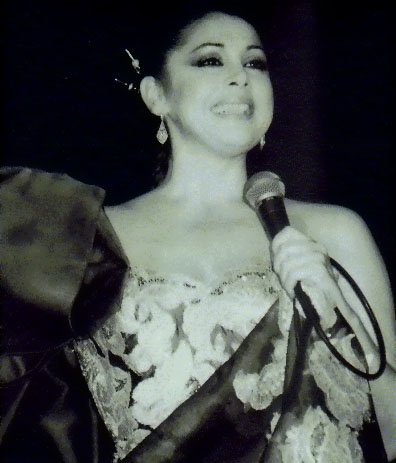 Isabel carried on that same summer performing all over Spain. Sometimes she used to coincide with her husband in those places where he would bullfight in the afternoon, and she would sing in the evening. Isabel would never go to the bullring to see her husband bullfight; she would stay in the Hotel or home depending on the day. In August 1983, already three months pregnant, Isabel announced that she would carry on singing until autumn and would retire after that.
Isabel carried on that same summer performing all over Spain. Sometimes she used to coincide with her husband in those places where he would bullfight in the afternoon, and she would sing in the evening. Isabel would never go to the bullring to see her husband bullfight; she would stay in the Hotel or home depending on the day. In August 1983, already three months pregnant, Isabel announced that she would carry on singing until autumn and would retire after that.
Their son was born on the 9th February 1984. They named him Francisco Jose. The coming months were full of peace and happiness for the couple.
Unfortunately their happiness did not last long. On the 26th September 1984 Francisco Rivera "Paquirri" was killed by a bull named "Avispado". It was his last bullfight of the Spanish season, and little did he know it would be the last of his lifetime. The pictures of the bullfighter talking to the surgeon and everyone present went around the world. "Paquirri" showed courage with his words and calmness. He did not make it to the Hospital in Cordoba, where he arrived dead. It was a long journey from Pozoblanco where he was bullfighting to Cordoba. Isabel Pantoja already knowing of the tragic news began living her worst nightmare.
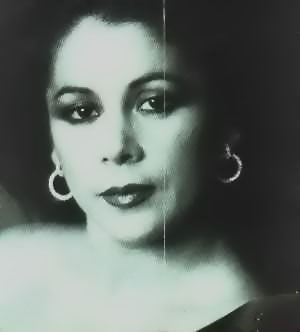 It took her more than a year before her comeback. During that time she only allowed one interview. The presentation of her new album "Marinero de Luces" took place on Nov 25th, in a massive reception, the album was penned and composed by Jose Luis Perales. The tracks of the album reflected Isabel's feelings and state of mind at the time, these were the songs the people were waiting for. The album sold more than a million copies.
It took her more than a year before her comeback. During that time she only allowed one interview. The presentation of her new album "Marinero de Luces" took place on Nov 25th, in a massive reception, the album was penned and composed by Jose Luis Perales. The tracks of the album reflected Isabel's feelings and state of mind at the time, these were the songs the people were waiting for. The album sold more than a million copies.
A few days later in December, she performed her new songs in a concert at the Lope de Vega theatre in Madrid. All proceeds of this concert went to the "Reina Sofia Foundation". The King and Queen of Spain received Isabel in private at the Zarzuela Palace.
And from then onwards hits after hits, after hits. Isabel Pantoja has consolidated herself as a top star combining her coplas of all time with ballads of today strengthening her acts with a few dance steps, and at times singing flamenco like bulerias, sevillanas and fandangos, which really are her roots.
In 1990 singer Victor Manuel's film production company, offered Isabel the leading role on a film titled "Yo Soy Esa", directed by Luis Sanz, founder of many stars today, and with a great knowledge of the Andalusian music. The film was a massive box hit, making over five hundred million pesetas. Jose Coronado was the male leading actor. At the same time a double album was released with twenty copla hits, it was titled "La Cancion Espanola". Not all of the twenty hits were actually featured in the motion picture. Luis Cobos featuring the Royal Philharmonic Orchestra directed the album. In the spring of 1991 Isabel shot her second movie as the leading role, the film was titled "El Dia Que Naci Yo". In this film there was less songs and more acting, giving Isabel the chance to show her acting skills. She really did a great job as an actress. The film was written by Jaime de Arminan, directed by Pedro Olea and co-starred with Isabel, Arturo Fernandez and Joaquin Almeida.
* In 1996 Isabel found another strong motive for her to carry on. A beautiful girl from Peru filled her life and heart completely, together with her Son Francisco. maria Isabel, gave Isabel new hopes and faith. With the coming of her daughter, Isabel finally felt complete as a mother, artist and most important of all as a person.
Even though Isabel has expressed many times that she wants to retire soon, so that she can dedicate more time to her family, Isabel Pantoja has carried on her successful professional life. Only her and Rocio Jurado have managed at this time and age to keep the sacred flame of the myth and living legend of "La Copla" alive.
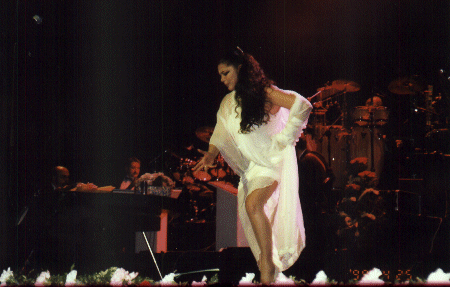 When Isabel performs, her audience can taste and feel her voice, her professionalism, leaving aside all their worries. This can only be achieved when listening to great stars like Isabel, when her audience, just by listening to her singing and seeing her perform, forgets there's a real world outside.
When Isabel performs, her audience can taste and feel her voice, her professionalism, leaving aside all their worries. This can only be achieved when listening to great stars like Isabel, when her audience, just by listening to her singing and seeing her perform, forgets there's a real world outside.
Biography taken from
"Memoria De La Copla" of Manuel Román, except * Douglas Mclaren.
Translation by Douglas Mclaren.
![[LOGO]](newlogor.jpg) Copyright © 1999 - 2010
reina-de-la-copla.com
Copyright © 1999 - 2010
reina-de-la-copla.com
 Maria Isabel Pantoja Martin was born on the 2nd August 1956 in Seville, at number 8 Juan de Diez Solis street, situated in San Gonzalo district, better known as "el Tardon", near Triana. Her paternal grandfather was "El Pipono de Jerez", gypsy singer. Her father, Juan Pantoja, who was nicknamed "Chiquetete", formed part of "Los Gaditanos" who made famous around the fifties the song "Que bonita que es mi nina", penned by F.del Val. Juan Pantoja wrote lyrics for some "fandangos". He was very much respected within the artistic world for his talent, and he never wanted her daughter Maribel to become an artist. Juan Pantoja was married to a flamenco dancer called Ana Martin. They both frequently worked with "Pepe Pinto and "La Nina de los Peines". In actual fact this two became the Godparents in their wedding. Later, Ana Maria formed part of "Juanita Reina's" group of dancers.
Maria Isabel Pantoja Martin was born on the 2nd August 1956 in Seville, at number 8 Juan de Diez Solis street, situated in San Gonzalo district, better known as "el Tardon", near Triana. Her paternal grandfather was "El Pipono de Jerez", gypsy singer. Her father, Juan Pantoja, who was nicknamed "Chiquetete", formed part of "Los Gaditanos" who made famous around the fifties the song "Que bonita que es mi nina", penned by F.del Val. Juan Pantoja wrote lyrics for some "fandangos". He was very much respected within the artistic world for his talent, and he never wanted her daughter Maribel to become an artist. Juan Pantoja was married to a flamenco dancer called Ana Martin. They both frequently worked with "Pepe Pinto and "La Nina de los Peines". In actual fact this two became the Godparents in their wedding. Later, Ana Maria formed part of "Juanita Reina's" group of dancers.
 Isabel was only seven years old when she first stepped foot on a stage, it was in Seville in the theatre "San Fernando", the event was a tribute to "Juanito Valderama" and "Dolores Abril" who Juan Pantoja used to perform in their show. As a gift for her performance, Isabel was given three gas balloons.
Isabel was only seven years old when she first stepped foot on a stage, it was in Seville in the theatre "San Fernando", the event was a tribute to "Juanito Valderama" and "Dolores Abril" who Juan Pantoja used to perform in their show. As a gift for her performance, Isabel was given three gas balloons.
 The girl was turning into a young woman, without hardly enjoying her childhood. She hardly played with girls of her own age. She used to go to school, attended dance and singing classes and she practically lived to her mother's orders, who was the head of the family, while her father was recovering from his illness.
The girl was turning into a young woman, without hardly enjoying her childhood. She hardly played with girls of her own age. She used to go to school, attended dance and singing classes and she practically lived to her mother's orders, who was the head of the family, while her father was recovering from his illness. Isabel performed as a dancer, whilst her cousin Antonio Cortes (who later became the well known "Chiquetete") did the singing. She gets paid at the time two hundred pesetas daily. The owner of the "tablao" was amazed with Isabel performance and encouraged her to sing. Doing cover versions of hits from Juanita Reina,Marife de Triana and Rocio Jurado, being these her favorites artists at the time. Negron spoke with Rafael de Leon and Juan Solano during one of their stays in the Hotel Colon of Seville. The writer and the composer both accepted the invitation to go and see for themselves this new promising artist in the "El Embrujo".
Isabel performed as a dancer, whilst her cousin Antonio Cortes (who later became the well known "Chiquetete") did the singing. She gets paid at the time two hundred pesetas daily. The owner of the "tablao" was amazed with Isabel performance and encouraged her to sing. Doing cover versions of hits from Juanita Reina,Marife de Triana and Rocio Jurado, being these her favorites artists at the time. Negron spoke with Rafael de Leon and Juan Solano during one of their stays in the Hotel Colon of Seville. The writer and the composer both accepted the invitation to go and see for themselves this new promising artist in the "El Embrujo".
 If we forget about the album she recorded with the flamenco act in Mallorca, her recording debut as a star was in 1974. Solano prepared the material for her first solo album. The opening track of side A was a track composed by himself and penned by Rafael de Leon, which had been previously recorded by Conchita Marquez Piquer with no luck,it was titled "Fue por tu voz". Followed by other tracks from the same authors like "Ten compasion de mi" and "Un rojo, rojo clavel", being this last one a massive hit for Rocio Jurado. The album also contained tracks from other authors like, Ochaita, Valerio and Solano.
If we forget about the album she recorded with the flamenco act in Mallorca, her recording debut as a star was in 1974. Solano prepared the material for her first solo album. The opening track of side A was a track composed by himself and penned by Rafael de Leon, which had been previously recorded by Conchita Marquez Piquer with no luck,it was titled "Fue por tu voz". Followed by other tracks from the same authors like "Ten compasion de mi" and "Un rojo, rojo clavel", being this last one a massive hit for Rocio Jurado. The album also contained tracks from other authors like, Ochaita, Valerio and Solano.
 Isabel carried on that same summer performing all over Spain. Sometimes she used to coincide with her husband in those places where he would bullfight in the afternoon, and she would sing in the evening. Isabel would never go to the bullring to see her husband bullfight; she would stay in the Hotel or home depending on the day. In August 1983, already three months pregnant, Isabel announced that she would carry on singing until autumn and would retire after that.
Isabel carried on that same summer performing all over Spain. Sometimes she used to coincide with her husband in those places where he would bullfight in the afternoon, and she would sing in the evening. Isabel would never go to the bullring to see her husband bullfight; she would stay in the Hotel or home depending on the day. In August 1983, already three months pregnant, Isabel announced that she would carry on singing until autumn and would retire after that.
 It took her more than a year before her comeback. During that time she only allowed one interview. The presentation of her new album "Marinero de Luces" took place on Nov 25th, in a massive reception, the album was penned and composed by Jose Luis Perales. The tracks of the album reflected Isabel's feelings and state of mind at the time, these were the songs the people were waiting for. The album sold more than a million copies.
It took her more than a year before her comeback. During that time she only allowed one interview. The presentation of her new album "Marinero de Luces" took place on Nov 25th, in a massive reception, the album was penned and composed by Jose Luis Perales. The tracks of the album reflected Isabel's feelings and state of mind at the time, these were the songs the people were waiting for. The album sold more than a million copies.
![[YO SOY ESA (Film Poster)]](esa.jpg)
![[LA CANCION ESPANOLA (Cover Photo}]](canesp.jpg)
![[EL DIA QUE NACI YO {Film Poster}]](dia.jpg)
 When Isabel performs, her audience can taste and feel her voice, her professionalism, leaving aside all their worries. This can only be achieved when listening to great stars like Isabel, when her audience, just by listening to her singing and seeing her perform, forgets there's a real world outside.
When Isabel performs, her audience can taste and feel her voice, her professionalism, leaving aside all their worries. This can only be achieved when listening to great stars like Isabel, when her audience, just by listening to her singing and seeing her perform, forgets there's a real world outside.

![[Discografía de toda una ESTRELLA ]](newdiscobanner.jpg)